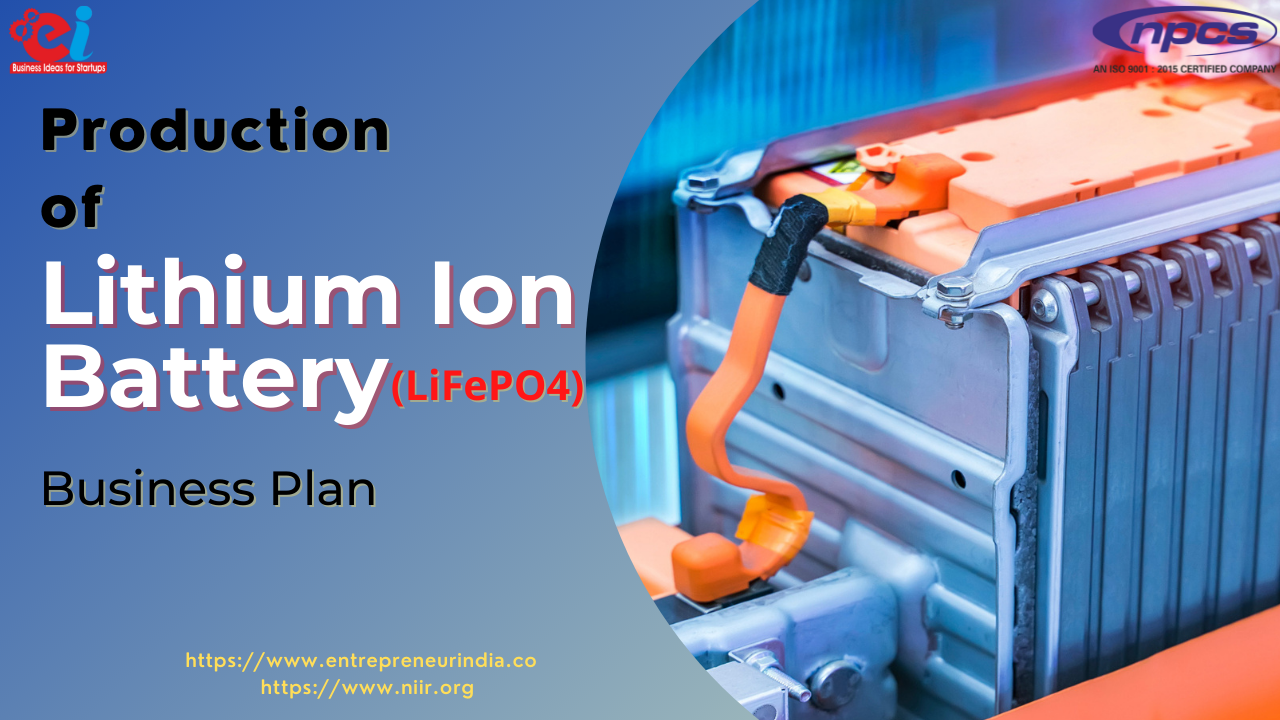
The lithium ion battery or Li-ion battery for short, is a type of rechargeable battery in which lithium ions move from the negative electrode to positive electrode during discharge and back when charging. A lithium ion batteries can be recharged more times than other types of rechargeable batteries. Typical uses for these batteries include mobile phones, laptop computers, digital cameras and camcorders.
Visit this Page for More Information: Start a Business in Lithium-Ion Battery Production
Li-ion batteries use an intercalated lithium compound as one electrode material, compared to the metallic lithium used in a non-rechargeable lithium battery. When compared to other types of batteries with equivalent energy storage capacity, it has a high energy density and is light weight. They have a design that is similar to lead acid, nickel cadmium, and NiMH secondary batteries. Their electrolyte, which is made up of lithium salts, makes a substantial impact. Lithium ion batteries are important not just because of their low cost, but also because of their capacity to hold a charge for longer periods of time.
Read Similar Articles: Battery Projects
Uses
- In Large electric vehicles include buses, electric automobiles, tour buses, hybrid vehicles, and other attractions.
- In Forklifts, electric vehicle cleaning wheelchairs, and other light electric vehicles include electric cycles, golf carts, small cars, forklifts, and other light electric vehicles.
- In Power tools include lawn movers, electric saws, and electric drills.
- In Cars, boats, planes, and other vehicles are among the toys that may be operated remotely.
- In Solar panels and wind energy storage are two examples of renewable energy sources.
- In Examples include warning lights, UPS, miner’s lamp, emergency lights, and so on.
- In Small medical equipment and medical gadgets.
Watch other Informative Videos: Electrical, Electronic Industries and Power Projects
Manufacturing process
Raw ingredients for a LiFePO4 battery are lithium oxide (Li2O), iron oxide (Fe2O3), and polypropylene (PP) resin. Cathode, graphite anode, and separator are formed by combining these elements. After that, they’re put in a mould to assist mould them into their final shape before being rolled into sheets or cut into coins or other shapes, depending on what you want to make. Various chemicals can be added to LiFePO4 batteries in addition to lithium oxides to change parameters like as conductivity, energy density, cycle life, or safety for specific purposes.
1. Use/Disposal Now that your lithium ion battery has been created, take care of it properly when storing and using it to maximize its lifespan!
2. Discharge
3. Storage
4. Recharge
5. Disassembly
6. Recycling
Related Report: E- Vehicle, E-Rickshaw, Hybrid Electric Scooter, Battery Operated Vehicle, Electric Vehicles, Battery Operated Electric Rickshaw
Market Outlook:
The lithium ion battery market is estimated to increase at a CAGR of 12.6 percent from 2020 to 2027, reaching USD 3,203.01 million by 2027. The market is expanding due to the growing demand for lithium ion batteries in medical devices. Lithium ions flow from the negative electrode to the positive electrode through the electrolyte during charging and backwards during discharging in a lithium ion battery. These rechargeable batteries are widely utilised in consumer electronics and autos. Cathode, anode, separator, and electrolyte are the four components. Anode aids in the storage and release of lithium ions from the cathode, allowing current to flow through an external circuit.
Related Feasibility Study Project: Battery Projects, Automobile Batteries, Lead Acid Battery, Lithium Battery, Lithium-Ion (Li-Ion) Battery, Maintenance Free Rechargeable Battery, Battery Recycling, Battery Plate, Battery Separator
The lithium iron phosphate batteries market is expected to grow at a CAGR of 5.0 percent from an estimated USD 8.3 billion in 2019 to USD 10.6 billion by 2024. The increased focus on electric and hybrid electric vehicles, as well as rising demand for energy storage applications, are responsible for this expansion.
See More Links:
Related Market Research Reports
Start a Business in Potential Countries for Doing Business
Best Industry for Doing Business
Business Ideas with Low, Medium & High Investment
Looking for Most Demandable Business Ideas for Startups
Start a Business in Middle East
𝐂𝐨𝐧𝐭𝐚𝐜𝐭 𝐮𝐬
NIIR PROJECT CONSULTANCY SERVICES, DELHI
An ISO 9001:2015 Company
ENTREPRENEUR INDIA
106-E, Kamla Nagar, Opp. Mall ST,
New Delhi-110007, India.
Email: npcs.ei@gmail.com
Tel: +91-11-23843955, 23845654, 23845886
Mobile: +91-9097075054, 8800733955
Website: https://www.entrepreneurindia.co

